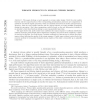Free Online Productivity Tools
i2Speak
i2Symbol
i2OCR
iTex2Img
iWeb2Print
iWeb2Shot
i2Type
iPdf2Split
iPdf2Merge
i2Bopomofo
i2Arabic
i2Style
i2Image
i2PDF
iLatex2Rtf
Sci2ools
98
Voted
CORR
2006
Springer
2006
Springer
Wreath Products in Stream Cipher Design
The paper develops a novel approach to stream cipher design: Both the state update function and the output function of the corresponding pseudorandom generators are compositions of arithmetic and bitwise logical operations, which are standard instructions of modern microprocessors. Moreover, both the state update function and the output function are being modified dynamically during the encryption. Also, these compositions could be keyed, so the only information available to an attacker is that these functions belong to some exponentially large class. The paper shows that under rather loose conditions the output sequence is uniformly distributed, achieves maximum period length and has high linear complexity and -error linear complexity. Ciphers of this kind are flexible: One could choose a suitable combination of instructions to obtain due performance without affecting the quality of the output sequence. Finally, some evidence is given that a key recovery problem for (reasonably design...
| Added | 11 Dec 2010 |
| Updated | 11 Dec 2010 |
| Type | Journal |
| Year | 2006 |
| Where | CORR |
| Authors | Vladimir Anashin |
Comments (0)

